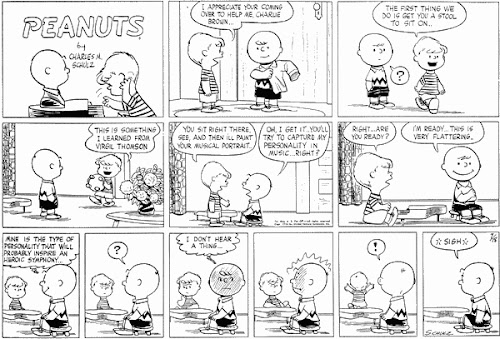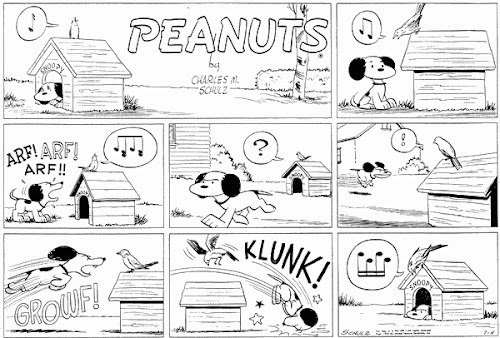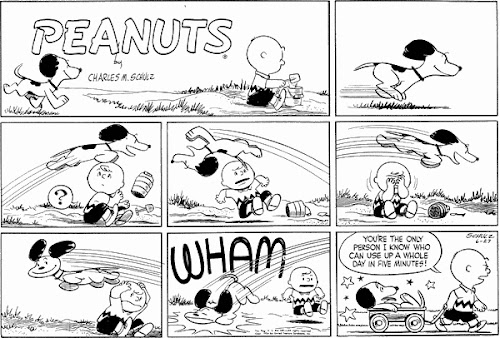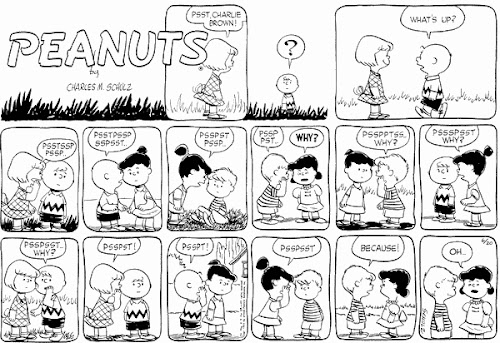July 12
It's funny, but before Linus comes on the scene, Lucy fills many of the same rolls, as someone Charlie Brown can just talk to. Maybe that's why she's so cruel to Linus.
July 13
He's here! This is Pig-Pen's first strip, and it's also the first real sequence in Peanuts, by which I mean, a good number of strips in a row that all deal with the same thing. Schulz has done multiple strips on a topic many times up to this point, but he's spread them out. (Lucy in the Golf Tournament could be considered such a sequence I suppose, but it's only over Sunday strips.)
Pig-Pen is also the first of a long long of minor characters. (Unless you could the realistic bird that harassed Snoopy recently, who has been seen once before.) And he's the most persistent of all of Peanuts' side cast. Sometimes months or even years may go between appearances, but Schulz never completely forgets about the kid. Contrast this with Charlotte Braun, or 5, or Roy, or Molly Volley. Pig-Pen is also longer-lived than most later major characters. Frieda appears frequently for a while, as does Eudora for a while, but both of them eventually fade into obscurity, while Pig-Pen remains, as steady as the earth with which he is covered.
Pig-Pen's annoyed statement that he doesn't have a name is funny, but is largely accurate. We never, to my knowledge, get a name for him.
Notice that it's Patty that first meets the kid. Violet and Lucy were first met by Charlie Brown. Schroeder was first met by Patty off-stage, but his first strip also had Charlie Brown. There! That's enough OCD for one day....
Patty describes Pig-Pen as "little," putting his age less than both hers and CB's. We don't yet have any information on whether Lucy is older or younger. While the ages between characters tend to compress over time, the order remains the same I think. This puts the order of ages at (">" means "is older than"):
Shermy & Patty > Charlie Brown > Violet > Schroeder > Pig-Pen & Lucy > Linus
July 14
Pig-Pen is the most zen-like of Peanuts' cast, even more so than Linus I think. He's a one-joke character but is very self-assured in his quirk. He sees absolutely nothing wrong with his messiness, he's comfortable with it, and I think there's something admirable in that.
July 15
Pig-Pen also has a sense of humor about himself. That implies being able to see himself from others' perspective, which itself implies maturity. Alternatively we could consider that this means he's internalized his messiness and considers it an alterable part of his personality, which could be regarded as a problem.
July 16
Snoopy's got word bubbles for his thoughts again. He actually uses them here while around another character; we're expected to see, I think, that his comments are a kind of internal monologue, presented theatrically.
July 17
Pig-Pen must spend a substantial amount of his time in the cleanliness/messiness cycle. Again, he is fully cognizant of his "fault," and doesn't consider it a fault at all. Later strips make it clear that Pig-Pen's dirtiness is actually a quasi-magical attribute; he gets dirty just walking down the street.
Pig-Pen's untied shoes are a nice touch.


































